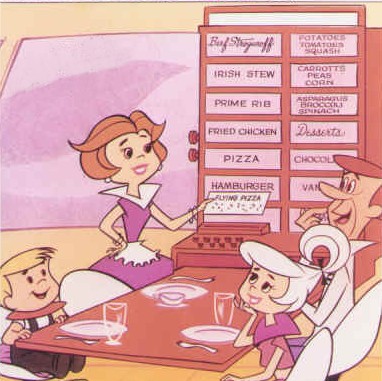 NASA and printable food. I can’t stop thinking about the Jetsons enjoying their utopian food pills. Which never happened, of course, because it’s a dumb idea.
NASA and printable food. I can’t stop thinking about the Jetsons enjoying their utopian food pills. Which never happened, of course, because it’s a dumb idea.
Printable food doesn’t sound all that much more appealing than those Jetsons food pills. But the stories deal with that issue – “If eating something spat out by the same kind of 3D printers…doesn’t sound too appetizing, that’s only because you can currently afford the good stuff.”
Meaning as real food becomes more scarce, people will happily eat printed food over no food.
Ok, I agree that people would eat printed food rather than go hungry. But I don’t understand how printed food will solve hunger.
The printer ingredients will be food with moisture removed – presumably dehydrated or freeze dried stuff. That exists today and has 30+ year storage life. Campers and hikers use it all the time because without the water weight this stuff is very easy to carry. You just add water and you get pretty tasty food.
It isn’t cheap, though. Freeze drying in particular is a fairly expensive process. And both freeze drying and dehydration remove nutrients from the food (particularly Vitamin C, I believe). It’s also quite hard to store fats long term. I assume long term space flights would focus on growing fats in plants for the trip, not packing them along from earth.
Bottom line, you still have to start with actual food for these printers, and then go through a costly process to dehydrate or freeze dry it, along with other processing. And then incur yet more costs (equipement and energy and service of equipment) to “print it out.”
Perhaps this gives astronauts more variety and precision in space over regular freeze dried/dehydrated food. But I don’t see why, anytime in our lifetimes, a food printer would make sense in our kitchens. It would likely taste worse than real food, and yet require the same amount of real food to produce.
The way to end hunger is to have less people, and to phase out meat in general over plant based foods. Ending corruption in food aid would also go a long way to ending hunger. Food printers? Not so much.
As averages work out, there is technically plenty of food, and plenty of fertile land to grow food, but those resources aren’t distributed amongst states evenly. Some places have the bad combination of high population and a lack of that resource (fertile soil to grow food). On a microcosm, it’s true for regions of U.S. as well. Without shipping and proximity to CA, Las Vegas would never be able to sustain the population it has. Some places require farmers to use too much water, while other places are lucky enough to have the problem of battling too much moisture. The “relatively free” market, and the ability to freely transport goods has the United States positioned with an abundance of food.
Trade embargoes, UN sanctions, price controls, and state run / bureaucratic economies are the real starvation culprits. Places suffering from starvation, usually have those in large supply. Printed food won’t solve that. Cooperation, pro free market states and entrepreneurship can solve hunger quicker than draconian measures like printable food, less people and phasing out meat.
Isn’t the current batch of food printing trchnologies working on a way to actually grow proteins in labs? If growing proteins in a lab only requires to grow the protein fibers (from a small animal sample) and not the actual full blown animal which includes all the parts that require energy and nutrients to get built and that we mostly disregard (organs, skin, hairs, bones, etc.), assuming prices become cheap in the long run, wouldn’t that save a lot of resources, money, and make such printable meat readily available everywhere?
Also, there is a difference between printable food and printable proteins. What i believe will happen is that future food security will be based on a combination of plant based diets, along with printed proteins. Which doesn’t sound too appealing, but considering the sorry state of the oceans, and the amount of water, pollution, land and animal rights abuses it takes to raise cattle, we need to find a viable alternative as we are unable to censor ourselves and be sensible.
To sum up, food printers aren’t going to be used to print an actual meal, but to print some of the building blocks of a meal, which would require far leas energy and resources than if they were being produced by conventional methods.
My 2 cents!
If you can create a high quality synthetic alternative food substance, then you could probably reduce the cost of food, however with petrochemicals, and mono culture agriculture, coupled with GMO(genetically modified organisms ), and processed foods, our food lacks the nutrients our food once had, even the vedigatables.
Reblogged this on omo10.
In a weightless environment controlling moisture becomes difficult. NASA has to do all sorts of things to prevent small droplets of water from pinging around. A food printer does away with many of these ‘systems’ and probably saves the astronaut some time and hassle to boot.
I, for once, am all for having “less people” around. Specially those before me in the line at Amici’s.
On the printable food business, well… I tried the predecessor of printable food. It was called “hand-painted” food. But the Macaroni Cheese crayon tasted just like the Apricot crayon, and like the Cotton Candy one…waxy…..
How about Soylent Green?
Reblogged this on qcsupermom and commented:
What is this world coming to? Printable food? Ugh, no thank you.